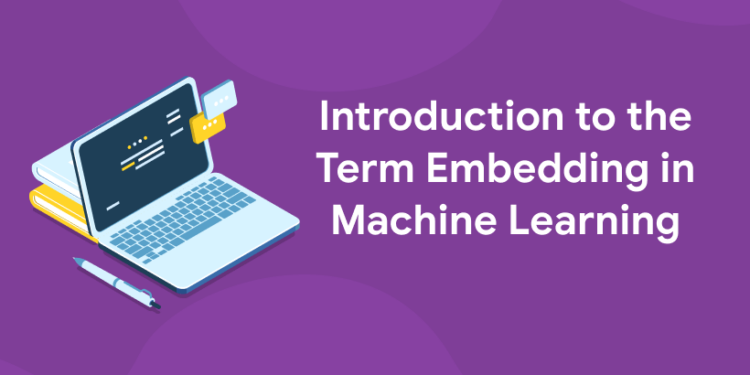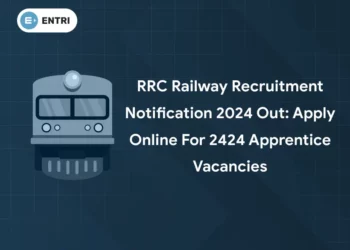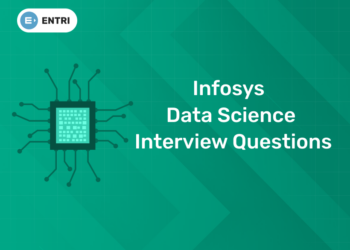Table of Contents
In machine learning, there are several approaches to representing information such as natural language texts, images, and videos in numerical structures (e.g., vectors). One of these approaches is the concept of embedding data into matrices or tensors (for NLP) or points in high-dimensional Euclidean space (for images and videos). This technique uses the common idea that two objects are similar if they are close together in Euclidean space; the distance between them can be calculated using the Euclidean distance formula, which gives values between 0 and 1. All of the concepts in machine learning stem from the math that underlies it, and one of the most important mathematical concepts underpinning machine learning is the concept of embedding. So what exactly does embedding mean? The word embedding itself has a number of definitions, but in this context, an embedding refers to a mapping from one vector space to another vector space, where both spaces have finite dimensions and the distance between vectors can be measured by ideal metrics like Euclidean distance or cosine similarity. One of the fundamental concepts in machine learning is understanding data. One of the main ways that this happens is through embeddings, which we’ll look at in detail below. In order to take full advantage of them, however, you need to know how they work and how to use them effectively in your own machine learning applications—and that’s what this article will help you do! Here are the tips on using embeddings in your machine learning models and applications.
Get the latest updates on machine learning in the Entri app
What Are Embeddings?
In machine learning, an embedding is a mapping from one vector space to another. Sometimes they’re used as features; other times they’re used as outputs. The input vectors are usually words or numbers, while output vectors are generally smaller than their inputs (thus we call them embeddings). A popular use of embeddings is to represent words and numbers with points in a graph, so we can visualize them and manipulate them mathematically. This way, you can think about words like cat and dog as being near each other because they have similar meanings. If you want to learn more about how these kinds of representations work, read our post on word2vec here. As with many things in machine learning, there’s not just one correct way to do it – there are lots of different types of embedding neural networks. There’s been a lot of research into different types of embeddings over time, but what makes all these approaches useful is that they allow us to find hidden structures within data that wouldn’t be apparent otherwise. One common example that illustrates why such mappings matter comes from natural language processing: given two sentences that contain similar words, it should be possible to guess whether those sentences are related by meaning.
To know more about machine learning in entri app
What is an Embedding Layer?
A neural network can be thought of as having two layers. The first layer accepts input and generates a feature representation. The second layer accepts an input (with feature representation) and generates a label (e.g., prediction). An embedding layer is an additional transformation applied to the data after it has passed through an original hidden layer, but before it reaches a classification layer. The output of an embedding neural network is typically a low-dimensional vector, or embedding, representing high-dimensional inputs. For example, if we have images of faces, then we might have a thousand pixels per image and each pixel could take on one of three values: red, green or blue. In that case our input would be 3000 dimensional (1000×3), while our output would only be 100 dimensional (3x3x3). This is because each pixel will now map to a single value instead of 3 values. This reduces complexity without losing any information. For example, given all pixels from an image we could reconstruct its full color information just by looking at these 100 dimensions.
Enroll in our latest machine learning course in Entri app
How Can You Create Your Own Embedding?
There are a lot of different ways to create embeddings, and you may need to experiment a bit before you find something that works well for your particular project. The most common types of embedding functions include: PCA, t-SNE, GloVe, or Hashing. The kind of information you’re trying to map can also determine which type of function is best. A great example comes from Natural Language Processing (NLP), where t-SNE is often used to map word vectors because words with similar meanings often have similar vector locations even if they don’t sound alike (like live and liveliness). It’s also useful to have an understanding of whether your embedding will be positive or negative in nature. In other words, does your data point towards one specific thing? For example, when mapping movie reviews onto stars it would make sense to use a negative embedding function. This way, each review would have a lower score than another review. On the other hand, if you were mapping movie titles onto stars it would make more sense to use a positive embedding so that each title has a higher score than another title.
Start your coding preparation with Entri app
Explore Different Ways Of Creating Your Own Embedding Functions
Typically, when we talk about embeddings, we’re referring to a word or phrase that has been mapped to some real-world representation. For example, New York might be mapped to a location on a map of New York City; that’s an example of an embedding function. In order to use these types of functions effectively, you’ll need to understand how they work and when it’s appropriate to use them. It’s also important not just to use one type of embedding neural network and assume it’s always best—try experimenting with different ways of creating your own embedding functions and then test them out on different datasets. Keep trying new techniques until you find something that works well with your data set. This is especially true if you want to create machine learning models that will generalize beyond your training data (which is a good idea). Just because an embedding function worked well for certain words doesn’t mean it will necessarily perform as well for others. This is why experimentation is so critical. If there are any words that don’t seem to be represented properly by your model, then try reworking its architecture. Don’t assume that simply tweaking weights or altering other hyperparameters will solve all of your problems—you may have designed a system that isn’t flexible enough!
Get the latest updates on machine learning in the Entri app
Which Pre-trained Embeddings Should I Use?
There are many pre-trained embeddings available. Some of them are trained on a variety of data such as Google News or movie reviews, and some of them have been pretrained to capture concepts from WordNet. It’s important to first have an understanding of what concept you’re trying to learn. WordNet is a great place to start because it contains basic information about words and their synonyms, hypernyms, and hyponyms (among other things). If you’re trying to learn more about your target language space that is likely not well represented by wordnet, other word embeddings like Glove or fastText are very useful because they’re pretrained on large bodies of text so they can capture domain specific semantics that wordnet can’t always capture. Once you’ve decided which pre-trained embedding is best suited for your task, it’s time to load up the weights! There are many ways to do so depending on what language you’re working with and how much memory you have at your disposal. I’ll focus on two popular methods: loading up pre-computed weights through Gensim and copying over vectors one by one using Numpy. In general, I would recommend copying over vectors one at a time if possible because it gives you full control over which vectors get copied when and where (this will be especially helpful if you want to use these vectors in multiple places). The downside of copying over each vector individually is that it takes longer than loading up all of the weights at once with Gensim.
To know more about machine learning in entri app
The Importance Of Dimensionality Reduction
There are two key reasons why reducing dimensionality is important. The first is that machine learning algorithms often rely on low-dimensional vectors, such as word embeddings, to do many of their important tasks. The second reason is that even when machine learning doesn’t rely on a low-dimensional vector directly, it may be helpful to lower-dimensionality to simplify or compress information contained within high-dimensional datasets. A good example of this is principal component analysis (PCA), which is a dimensionality reduction method and powerful data compression algorithm in its own right. In other words, it will likely be easier for humans to understand data represented by a smaller set of variables than a larger set of variables. This can also be said about clustering methods like k-means, where you want to reduce the number of clusters from a large number down to something more manageable. For example, if you were working with hundreds of thousands of images, you might want to cluster them into only ten different categories rather than hundreds or thousands! PCA and k-means are both examples where dimensionality reduction allows us to take advantage of human visual perception; we can see patterns more easily in fewer dimensions than higher ones.
Get the latest updates on machine learning in the Entri app
How Does Neural Machine Translation Use Embeddings?
If you have multiple columns of values that vary wildly, like age and income, it’s tempting to normalize them before using them as features. However, normalizing your data can decrease model performance. For example, because computers cannot store negative numbers, a negative weight would be saved as 0 by many software packages. So when you train a neural network with normalized data that has negative weights, it becomes impossible to tell whether those weights are zero or truly negative—and if they are negative (or zero), what those weights actually mean. Instead, use unnormalized data whenever possible. You may need to transform it slightly, but that’s okay. In addition, always ensure your training set is balanced so no single class is over-represented or under-represented compared to others. This will help prevent catastrophic failures during training and increase accuracy once you start deploying models into production environments. When dealing with words, one good way to achieve balance is to create a frequency distribution table from all your source text files. This tells you how often each word appears in your corpus; then you can split up your corpus into an equal number of buckets based on these frequencies. A good rule of thumb is 10 buckets per million words total, which translates roughly to 1 bucket per 10K words.
To know more about machine learning in entri app
Should I Normalize My Data Before Training My Model?
If you’re working with a particularly large dataset, you may want to think about whether or not normalizing your data makes sense. The reason for normalization is that different inputs can exhibit wildly different variances—some of which could skew our results. For example, if we were training a model on images of cats and dogs that looked like this: dog 1 = (1, 10), dog 2 = (2, 1), dog 3 = (3, 5) … If we were to apply normalization directly onto these vectors as they currently stand, they’d each get scaled down to zero mean and unit variance before getting added together into a single vector. In other words, their individual variances would be normalized to 0 before being combined. This means that even though dog 1 was way bigger than either dog 2 or 3, it gets shrunken down so it’s just as big as them after normalization. And then when we train our classifier, all three of those examples will contribute equally to our final result! This isn’t necessarily a bad thing—after all, having lots of examples from both classes is always better than having only one or two examples from each class. But what if there are more dogs than cats? What if there are twice as many dogs? Well then suddenly every single one of those dogs will make its way into our final result vector and dominate everything else!
Get the latest updates on machine learning in the Entri app
What Is Word2vec?
The word2vec algorithm (or more specifically, its successor, GloVe) is a way of modeling and representing words as vectors. Vectors are matrices that have dimensions; for example, you might model a cat as [0.9 0.01 -0.1 1], which would mean that cat was a vector with a length of four and contains values between 0.9 and 1 on each dimension (the x axis, y axis, and z axis). In practice, word2vec usually models words with 300 to 500 dimensions. You can think of these dimensions as coordinates in an n-dimensional space where n is equal to the number of dimensions used by your model. You can then use these coordinates to find other words similar to your input word. For example, if you wanted to find similar words to cat, you could use your word2vec representation of cat and look at all other words that were close by using those coordinates: [0.9 0.01 -0.1 1]. Since it’s so common for cat to be near terms like dog, fish, or bird, we’d say that they’re semantically related—even though they don’t necessarily share any direct linguistic similarities!
To know more about machine learning in entri app
How Do I Make Sense Of Word2vec Results?
Let’s say you run a word2vec program and it spits out a funny looking list of words, like so: [John, England, Englander, Englishmen, …] It looks crazy, but if you think about what word2vec is doing, it actually makes sense. Word2vec is taking two words and showing how similar they are based on how often they appear near each other. The distance between two words can be calculated by summing up all of their similarities. So king and queen would have a similarity score of 1 (since they always appear next to each other), while king and man would have 0 similarity scores because they never appear together. In fact, we can even look at every single word pair and figure out which ones have high similarity scores and which ones don’t. For example, let’s take a look at these pairs: king – queen : 1 king – man : 0 queen – woman : 0 Now that we know which pairs are close together, we can start asking questions about them! How many times do these pairs occur? Do any of them only occur once? Are there any new relationships that pop up when I group them into groups of 10? This is where things get interesting. If you are interested to learn new coding skills, the Entri app will help you to acquire them very easily. Entri app is following a structural study plan so that the students can learn very easily. If you don’t have a coding background, it won’t be any problem. You can download the Entri app from the google play store and enroll in your favorite course.











